Managing Human Resources
VerifiedAdded on 2023/01/11
|6
|1453
|51
AI Summary
This assignment discusses the approach of training and development in managing human resources. It provides an overview of the approach and the types of activities involved. It also explores the advantages, disadvantages, and budgeting considerations of this approach. Additionally, it examines the impact of internal and external factors on implementing this approach and how other companies use it successfully. The key reasons for adopting this approach are summarized as well.
Contribute Materials
Your contribution can guide someone’s learning journey. Share your
documents today.
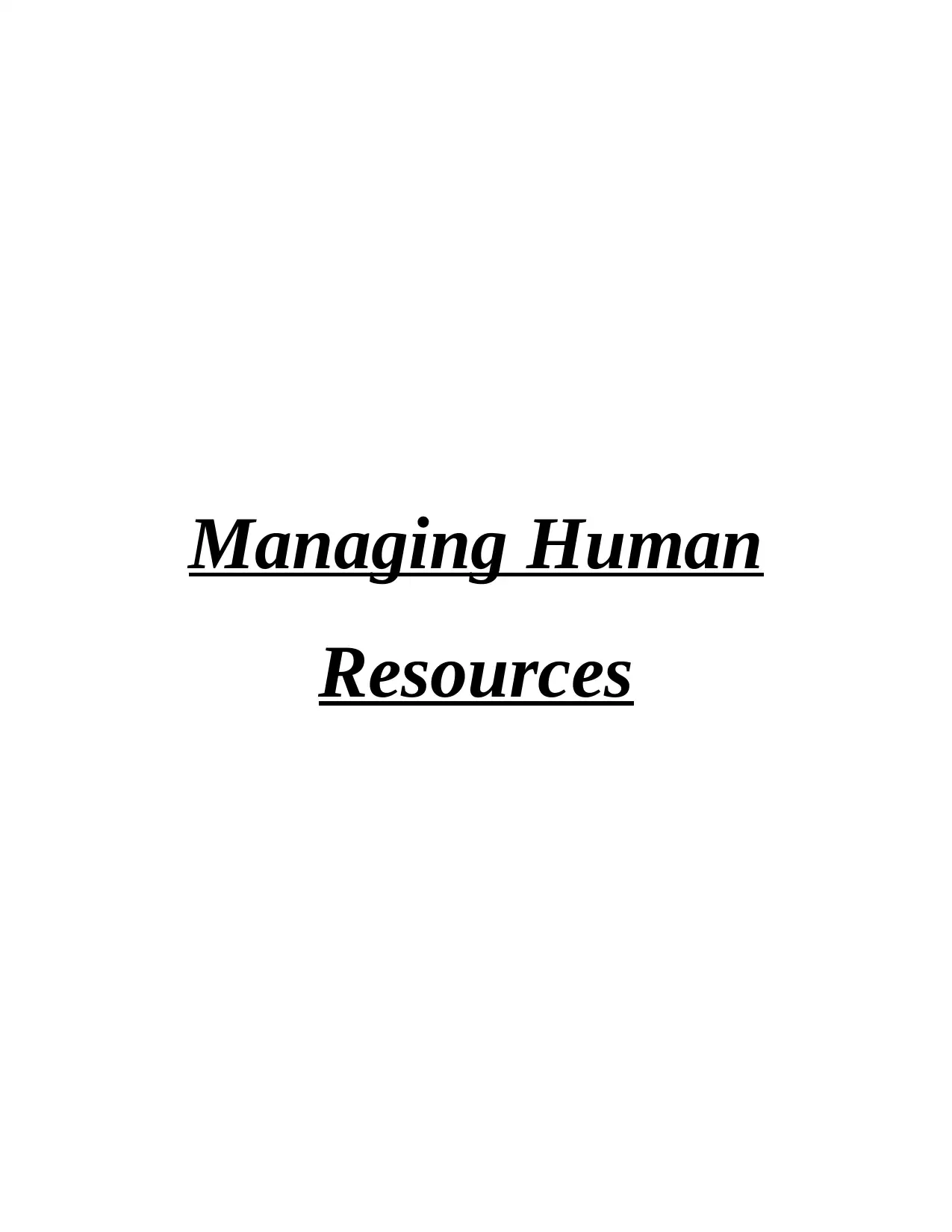
Managing Human
Resources
Resources
Secure Best Marks with AI Grader
Need help grading? Try our AI Grader for instant feedback on your assignments.
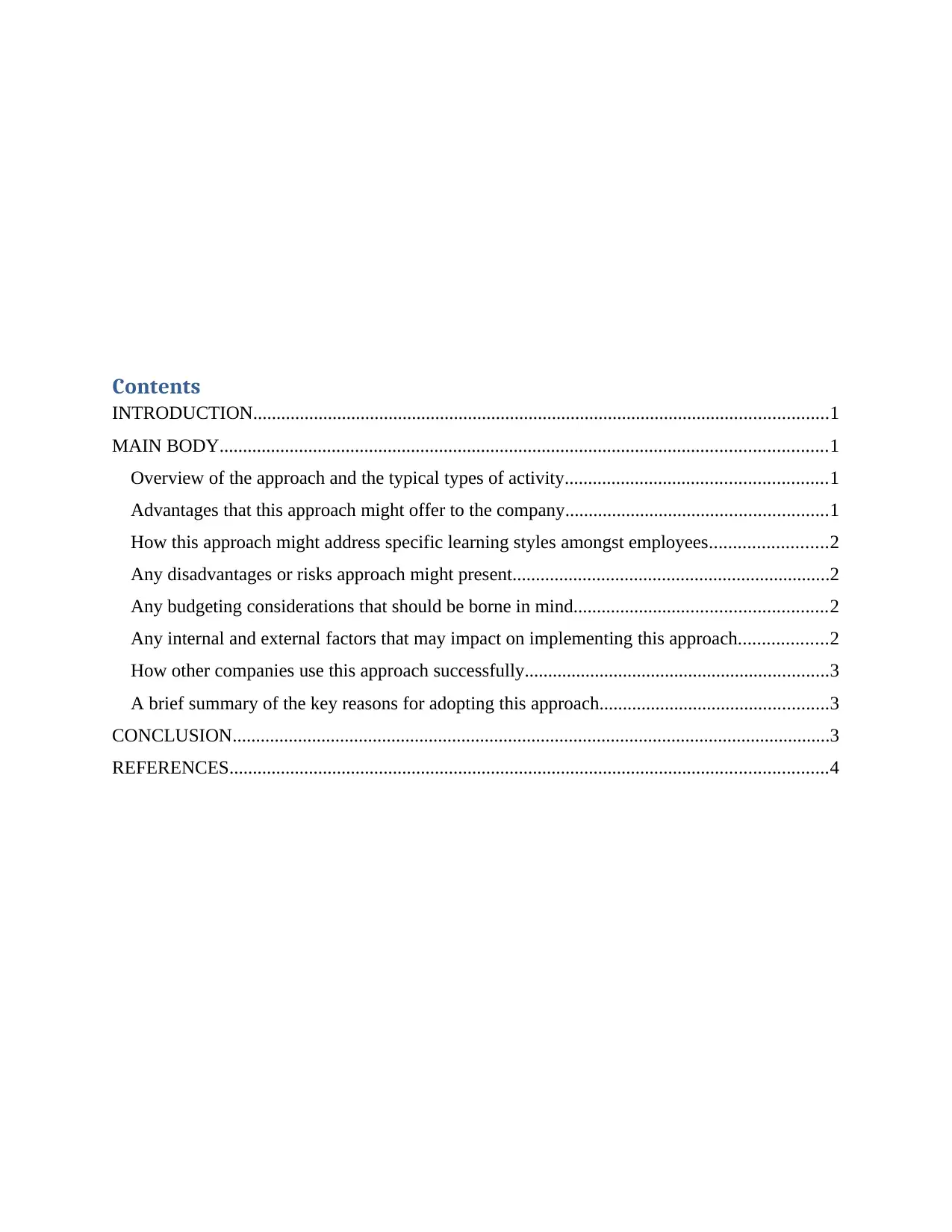
Contents
INTRODUCTION...........................................................................................................................1
MAIN BODY..................................................................................................................................1
Overview of the approach and the typical types of activity........................................................1
Advantages that this approach might offer to the company........................................................1
How this approach might address specific learning styles amongst employees.........................2
Any disadvantages or risks approach might present....................................................................2
Any budgeting considerations that should be borne in mind......................................................2
Any internal and external factors that may impact on implementing this approach...................2
How other companies use this approach successfully.................................................................3
A brief summary of the key reasons for adopting this approach.................................................3
CONCLUSION................................................................................................................................3
REFERENCES................................................................................................................................4
INTRODUCTION...........................................................................................................................1
MAIN BODY..................................................................................................................................1
Overview of the approach and the typical types of activity........................................................1
Advantages that this approach might offer to the company........................................................1
How this approach might address specific learning styles amongst employees.........................2
Any disadvantages or risks approach might present....................................................................2
Any budgeting considerations that should be borne in mind......................................................2
Any internal and external factors that may impact on implementing this approach...................2
How other companies use this approach successfully.................................................................3
A brief summary of the key reasons for adopting this approach.................................................3
CONCLUSION................................................................................................................................3
REFERENCES................................................................................................................................4
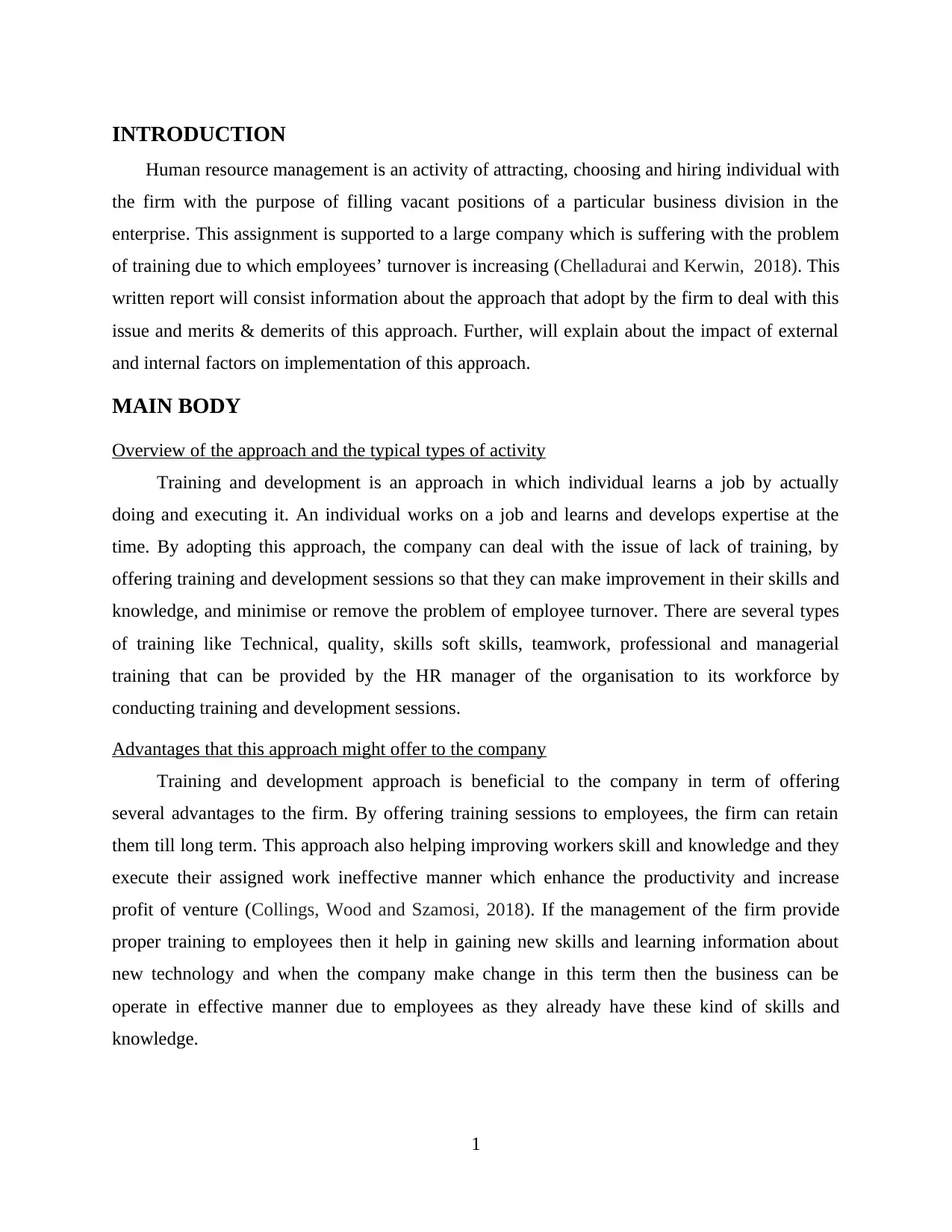
INTRODUCTION
Human resource management is an activity of attracting, choosing and hiring individual with
the firm with the purpose of filling vacant positions of a particular business division in the
enterprise. This assignment is supported to a large company which is suffering with the problem
of training due to which employees’ turnover is increasing (Chelladurai and Kerwin, 2018). This
written report will consist information about the approach that adopt by the firm to deal with this
issue and merits & demerits of this approach. Further, will explain about the impact of external
and internal factors on implementation of this approach.
MAIN BODY
Overview of the approach and the typical types of activity
Training and development is an approach in which individual learns a job by actually
doing and executing it. An individual works on a job and learns and develops expertise at the
time. By adopting this approach, the company can deal with the issue of lack of training, by
offering training and development sessions so that they can make improvement in their skills and
knowledge, and minimise or remove the problem of employee turnover. There are several types
of training like Technical, quality, skills soft skills, teamwork, professional and managerial
training that can be provided by the HR manager of the organisation to its workforce by
conducting training and development sessions.
Advantages that this approach might offer to the company
Training and development approach is beneficial to the company in term of offering
several advantages to the firm. By offering training sessions to employees, the firm can retain
them till long term. This approach also helping improving workers skill and knowledge and they
execute their assigned work ineffective manner which enhance the productivity and increase
profit of venture (Collings, Wood and Szamosi, 2018). If the management of the firm provide
proper training to employees then it help in gaining new skills and learning information about
new technology and when the company make change in this term then the business can be
operate in effective manner due to employees as they already have these kind of skills and
knowledge.
1
Human resource management is an activity of attracting, choosing and hiring individual with
the firm with the purpose of filling vacant positions of a particular business division in the
enterprise. This assignment is supported to a large company which is suffering with the problem
of training due to which employees’ turnover is increasing (Chelladurai and Kerwin, 2018). This
written report will consist information about the approach that adopt by the firm to deal with this
issue and merits & demerits of this approach. Further, will explain about the impact of external
and internal factors on implementation of this approach.
MAIN BODY
Overview of the approach and the typical types of activity
Training and development is an approach in which individual learns a job by actually
doing and executing it. An individual works on a job and learns and develops expertise at the
time. By adopting this approach, the company can deal with the issue of lack of training, by
offering training and development sessions so that they can make improvement in their skills and
knowledge, and minimise or remove the problem of employee turnover. There are several types
of training like Technical, quality, skills soft skills, teamwork, professional and managerial
training that can be provided by the HR manager of the organisation to its workforce by
conducting training and development sessions.
Advantages that this approach might offer to the company
Training and development approach is beneficial to the company in term of offering
several advantages to the firm. By offering training sessions to employees, the firm can retain
them till long term. This approach also helping improving workers skill and knowledge and they
execute their assigned work ineffective manner which enhance the productivity and increase
profit of venture (Collings, Wood and Szamosi, 2018). If the management of the firm provide
proper training to employees then it help in gaining new skills and learning information about
new technology and when the company make change in this term then the business can be
operate in effective manner due to employees as they already have these kind of skills and
knowledge.
1
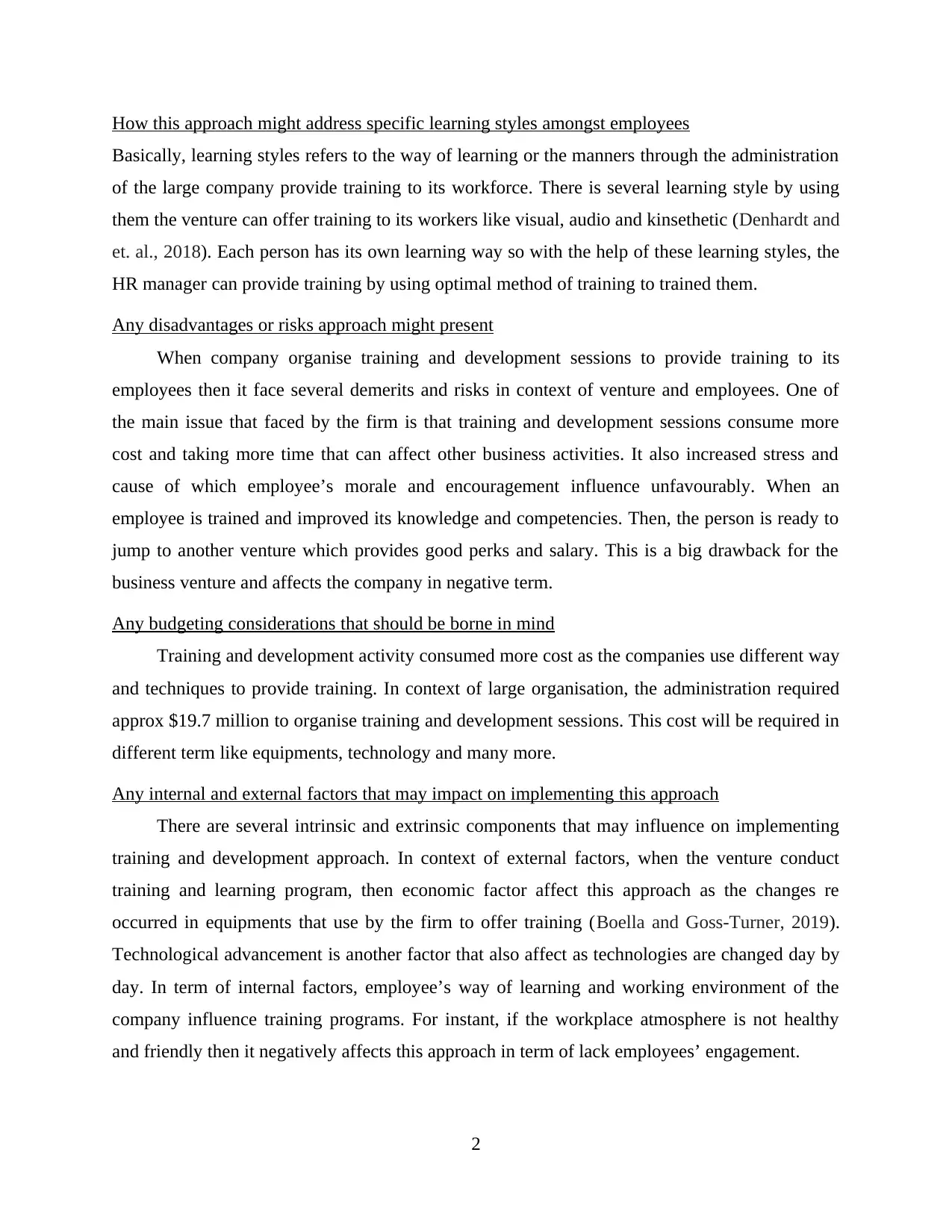
How this approach might address specific learning styles amongst employees
Basically, learning styles refers to the way of learning or the manners through the administration
of the large company provide training to its workforce. There is several learning style by using
them the venture can offer training to its workers like visual, audio and kinsethetic (Denhardt and
et. al., 2018). Each person has its own learning way so with the help of these learning styles, the
HR manager can provide training by using optimal method of training to trained them.
Any disadvantages or risks approach might present
When company organise training and development sessions to provide training to its
employees then it face several demerits and risks in context of venture and employees. One of
the main issue that faced by the firm is that training and development sessions consume more
cost and taking more time that can affect other business activities. It also increased stress and
cause of which employee’s morale and encouragement influence unfavourably. When an
employee is trained and improved its knowledge and competencies. Then, the person is ready to
jump to another venture which provides good perks and salary. This is a big drawback for the
business venture and affects the company in negative term.
Any budgeting considerations that should be borne in mind
Training and development activity consumed more cost as the companies use different way
and techniques to provide training. In context of large organisation, the administration required
approx $19.7 million to organise training and development sessions. This cost will be required in
different term like equipments, technology and many more.
Any internal and external factors that may impact on implementing this approach
There are several intrinsic and extrinsic components that may influence on implementing
training and development approach. In context of external factors, when the venture conduct
training and learning program, then economic factor affect this approach as the changes re
occurred in equipments that use by the firm to offer training (Boella and Goss-Turner, 2019).
Technological advancement is another factor that also affect as technologies are changed day by
day. In term of internal factors, employee’s way of learning and working environment of the
company influence training programs. For instant, if the workplace atmosphere is not healthy
and friendly then it negatively affects this approach in term of lack employees’ engagement.
2
Basically, learning styles refers to the way of learning or the manners through the administration
of the large company provide training to its workforce. There is several learning style by using
them the venture can offer training to its workers like visual, audio and kinsethetic (Denhardt and
et. al., 2018). Each person has its own learning way so with the help of these learning styles, the
HR manager can provide training by using optimal method of training to trained them.
Any disadvantages or risks approach might present
When company organise training and development sessions to provide training to its
employees then it face several demerits and risks in context of venture and employees. One of
the main issue that faced by the firm is that training and development sessions consume more
cost and taking more time that can affect other business activities. It also increased stress and
cause of which employee’s morale and encouragement influence unfavourably. When an
employee is trained and improved its knowledge and competencies. Then, the person is ready to
jump to another venture which provides good perks and salary. This is a big drawback for the
business venture and affects the company in negative term.
Any budgeting considerations that should be borne in mind
Training and development activity consumed more cost as the companies use different way
and techniques to provide training. In context of large organisation, the administration required
approx $19.7 million to organise training and development sessions. This cost will be required in
different term like equipments, technology and many more.
Any internal and external factors that may impact on implementing this approach
There are several intrinsic and extrinsic components that may influence on implementing
training and development approach. In context of external factors, when the venture conduct
training and learning program, then economic factor affect this approach as the changes re
occurred in equipments that use by the firm to offer training (Boella and Goss-Turner, 2019).
Technological advancement is another factor that also affect as technologies are changed day by
day. In term of internal factors, employee’s way of learning and working environment of the
company influence training programs. For instant, if the workplace atmosphere is not healthy
and friendly then it negatively affects this approach in term of lack employees’ engagement.
2
Secure Best Marks with AI Grader
Need help grading? Try our AI Grader for instant feedback on your assignments.
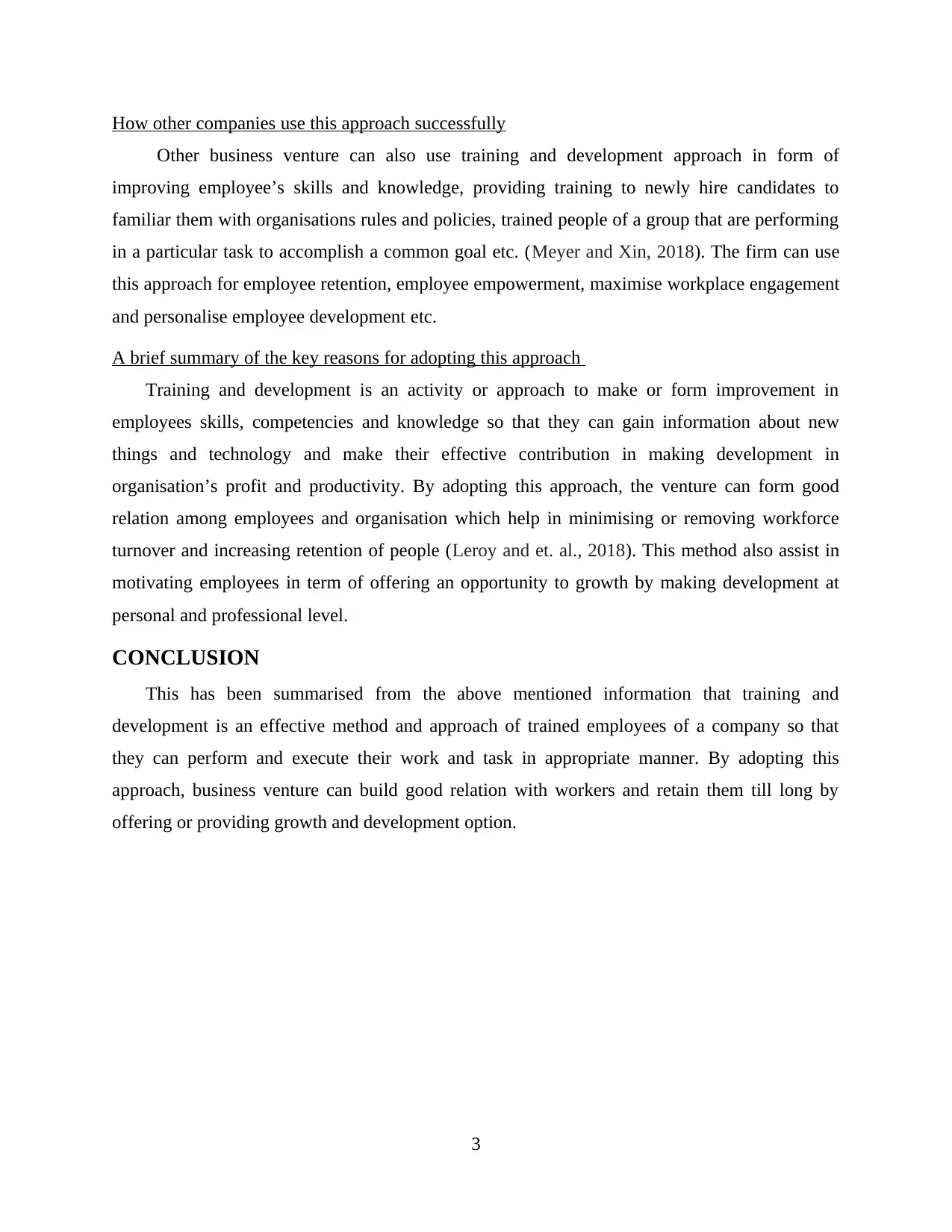
How other companies use this approach successfully
Other business venture can also use training and development approach in form of
improving employee’s skills and knowledge, providing training to newly hire candidates to
familiar them with organisations rules and policies, trained people of a group that are performing
in a particular task to accomplish a common goal etc. (Meyer and Xin, 2018). The firm can use
this approach for employee retention, employee empowerment, maximise workplace engagement
and personalise employee development etc.
A brief summary of the key reasons for adopting this approach
Training and development is an activity or approach to make or form improvement in
employees skills, competencies and knowledge so that they can gain information about new
things and technology and make their effective contribution in making development in
organisation’s profit and productivity. By adopting this approach, the venture can form good
relation among employees and organisation which help in minimising or removing workforce
turnover and increasing retention of people (Leroy and et. al., 2018). This method also assist in
motivating employees in term of offering an opportunity to growth by making development at
personal and professional level.
CONCLUSION
This has been summarised from the above mentioned information that training and
development is an effective method and approach of trained employees of a company so that
they can perform and execute their work and task in appropriate manner. By adopting this
approach, business venture can build good relation with workers and retain them till long by
offering or providing growth and development option.
3
Other business venture can also use training and development approach in form of
improving employee’s skills and knowledge, providing training to newly hire candidates to
familiar them with organisations rules and policies, trained people of a group that are performing
in a particular task to accomplish a common goal etc. (Meyer and Xin, 2018). The firm can use
this approach for employee retention, employee empowerment, maximise workplace engagement
and personalise employee development etc.
A brief summary of the key reasons for adopting this approach
Training and development is an activity or approach to make or form improvement in
employees skills, competencies and knowledge so that they can gain information about new
things and technology and make their effective contribution in making development in
organisation’s profit and productivity. By adopting this approach, the venture can form good
relation among employees and organisation which help in minimising or removing workforce
turnover and increasing retention of people (Leroy and et. al., 2018). This method also assist in
motivating employees in term of offering an opportunity to growth by making development at
personal and professional level.
CONCLUSION
This has been summarised from the above mentioned information that training and
development is an effective method and approach of trained employees of a company so that
they can perform and execute their work and task in appropriate manner. By adopting this
approach, business venture can build good relation with workers and retain them till long by
offering or providing growth and development option.
3
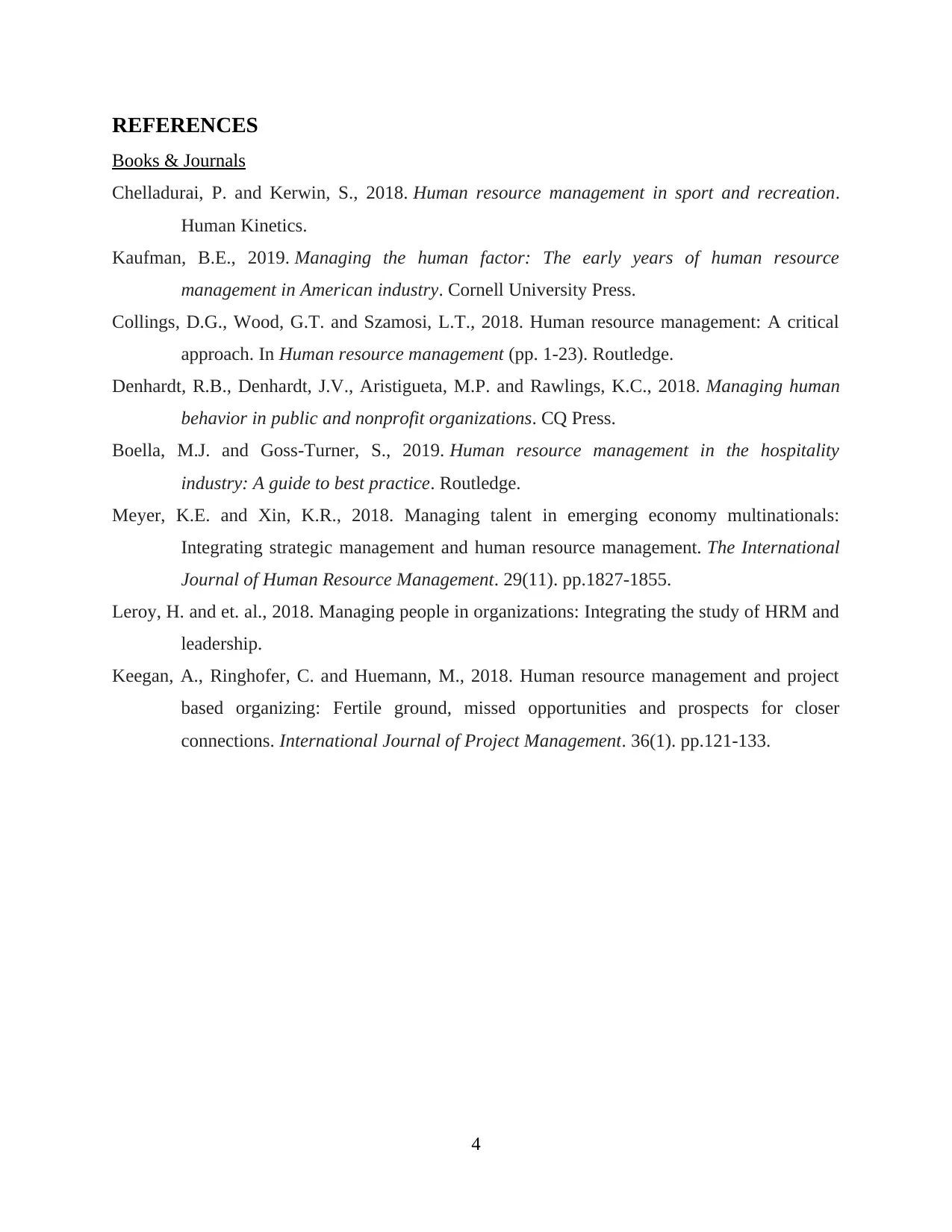
REFERENCES
Books & Journals
Chelladurai, P. and Kerwin, S., 2018. Human resource management in sport and recreation.
Human Kinetics.
Kaufman, B.E., 2019. Managing the human factor: The early years of human resource
management in American industry. Cornell University Press.
Collings, D.G., Wood, G.T. and Szamosi, L.T., 2018. Human resource management: A critical
approach. In Human resource management (pp. 1-23). Routledge.
Denhardt, R.B., Denhardt, J.V., Aristigueta, M.P. and Rawlings, K.C., 2018. Managing human
behavior in public and nonprofit organizations. CQ Press.
Boella, M.J. and Goss-Turner, S., 2019. Human resource management in the hospitality
industry: A guide to best practice. Routledge.
Meyer, K.E. and Xin, K.R., 2018. Managing talent in emerging economy multinationals:
Integrating strategic management and human resource management. The International
Journal of Human Resource Management. 29(11). pp.1827-1855.
Leroy, H. and et. al., 2018. Managing people in organizations: Integrating the study of HRM and
leadership.
Keegan, A., Ringhofer, C. and Huemann, M., 2018. Human resource management and project
based organizing: Fertile ground, missed opportunities and prospects for closer
connections. International Journal of Project Management. 36(1). pp.121-133.
4
Books & Journals
Chelladurai, P. and Kerwin, S., 2018. Human resource management in sport and recreation.
Human Kinetics.
Kaufman, B.E., 2019. Managing the human factor: The early years of human resource
management in American industry. Cornell University Press.
Collings, D.G., Wood, G.T. and Szamosi, L.T., 2018. Human resource management: A critical
approach. In Human resource management (pp. 1-23). Routledge.
Denhardt, R.B., Denhardt, J.V., Aristigueta, M.P. and Rawlings, K.C., 2018. Managing human
behavior in public and nonprofit organizations. CQ Press.
Boella, M.J. and Goss-Turner, S., 2019. Human resource management in the hospitality
industry: A guide to best practice. Routledge.
Meyer, K.E. and Xin, K.R., 2018. Managing talent in emerging economy multinationals:
Integrating strategic management and human resource management. The International
Journal of Human Resource Management. 29(11). pp.1827-1855.
Leroy, H. and et. al., 2018. Managing people in organizations: Integrating the study of HRM and
leadership.
Keegan, A., Ringhofer, C. and Huemann, M., 2018. Human resource management and project
based organizing: Fertile ground, missed opportunities and prospects for closer
connections. International Journal of Project Management. 36(1). pp.121-133.
4
1 out of 6
Related Documents
Your All-in-One AI-Powered Toolkit for Academic Success.
+13062052269
info@desklib.com
Available 24*7 on WhatsApp / Email
![[object Object]](/_next/static/media/star-bottom.7253800d.svg)
Unlock your academic potential
© 2024 | Zucol Services PVT LTD | All rights reserved.





